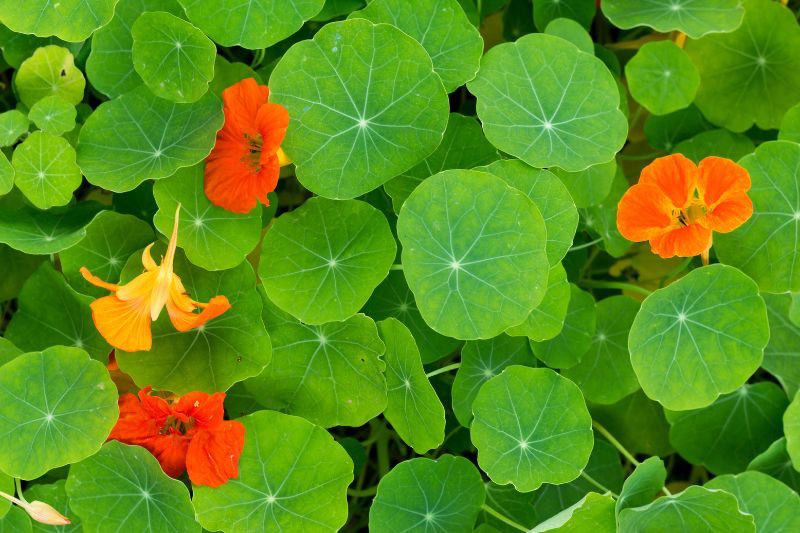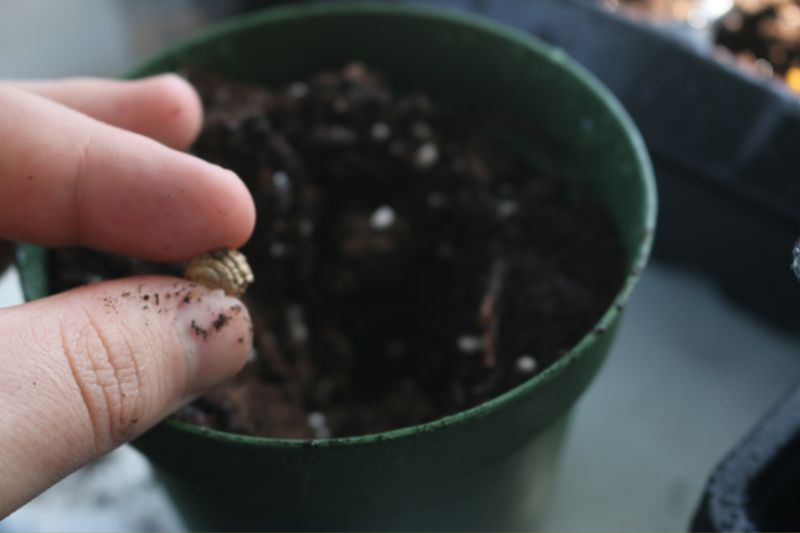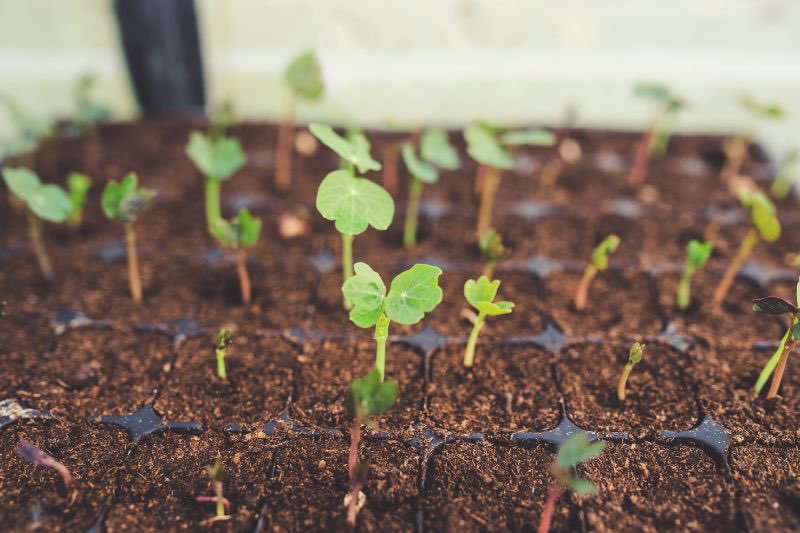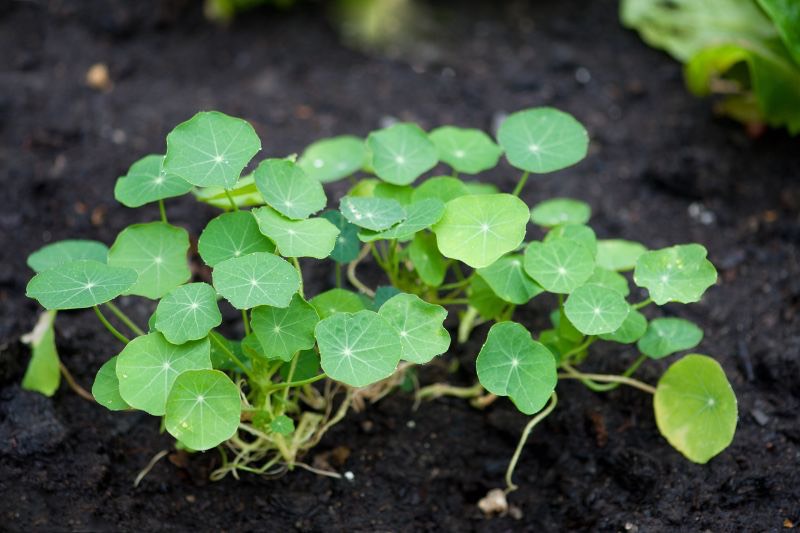Nasturtiums are charming plants often grown as annuals, due to their low hardiness. If they are so popular, it is because they have many qualities :
- a long summer flowering with trumpet-shaped blooms ; <li;brilliant and varied colours ;
- attractive rounded foliage ;
- rapid growth ;
- very varied uses (as groundcover, climbing, in flowering pots, as companion plants in vegetable beds or in the kitchen).
What's more, nasturtiums are among plants very easy to grow and to sow, even for novice gardeners or children. Here are our tips and tutorials to succeed in sowing nasturtiums.

Which nasturtiums to choose for sowing?
All nasturtiums are easy to sow : dwarf nasturtiums, climbing nasturtiums, single-flowered or double-flowered. You can choose a single variety or opt for a seed mix.
Seeds can be bought or harvested by you the previous year (see dedicated paragraph).
When to sow nasturtiums?
Under cover
In a heated greenhouse or conservatory, sowing nasturtiums can be done as early as February. In an unheated shelter or cold frame, sowing is rather in March–April, when ambient temperature reaches about 15°C.
This sowing allows earlier flowering compared with direct sowing outdoors. This option can be preferred in regions prone to late frosts, which do not allow sowing in open ground before mid-May.

Outdoors
Most nasturtiums are frost-tender and cannot tolerate sub-zero temperatures. Direct sowing in open ground should therefore be carried out once last frost risks have passed.
Mild regions can begin direct sowing from April, when soil has warmed (about 13°C). Colder regions should wait until mid-May and after the ice saints.
Sowing stages
Nasturtium seeds germinate fairly quickly, usually within 12–15 days.
To aid germination, we recommend soaking seeds in lukewarm water the day before sowing.
Expect about 2–3 months before first nasturtium flowers appear.
Sowing in buckets
- Prepare buckets about 6 cm tall.
- Fill them with seed compost, or with equal mix of horticultural compost and sand to improve drainage.
- Thoroughly moisten soil using a spray bottle.
- Place 2–3 seeds per container, spaced apart, then push them down to about 3 cm deep with your index finger.
- Cover with a thin layer of compost.
- Place buckets in a bright, airy position, at around 15–20°C.
- Keep constantly moist until seedlings emerge, watering preferably by misting or fine spray to avoid waterlogging soil.
- When plants have developed their first five leaves and reach about 8 cm tall, they can be transplanted into garden or pot. Before moving outdoors, wait until soil has warmed and frost risk is removed.
- Allow spacing of about 50 cm between climbing varieties and 30 cm between dwarf varieties.
- Install one or more stakes if you want climbing varieties to grow vertically rather than as groundcover.

Sowing in open ground
For sowing nasturtiums in open ground, choose a sunny, warm spot, sheltered from prevailing winds for climbing varieties. Nasturtiums do not need overly rich soil (except Canary nasturtium) : they prefer light, even poor soil.
- Prepare sowing area by weeding and removing any large pieces of wood, stones, etc.
- Loosen soil and add sand to improve drainage if needed.
- Rake or fork the surface to obtain a smooth, airy area.
- Using a stick, make planting holes about 2 cm deep; allow 30 cm spacing for dwarf varieties and 50 cm for climbers ;
- Sow in small clusters, i.e. place 2–3 seeds per hole.
- Cover seeds with garden soil mixed with seed compost, or with standard compost combined with sand.
- Press down lightly with hand.
- Water with a fine spray until seedlings emerge.
- Once plants reach 10 cm in height, thin out leaving only most vigorous plant. Transplant others to another area of garden or into pots.
- Install a stake or a trellis if you want climbing varieties to develop in height.

How to care for sown nasturtiums?
Water nasturtiums regularly at establishment, then during dry periods in summer. In autumn, reduce watering.
Increase watering when grown in containers, as soil dries more quickly.
To improve flowering, remove faded flowers as they appear. Also remove any yellowed or damaged leaves using a pruning shear.
Nasturtium is known for its ability to "attract" aphids, making it a good companion plant that protects other vegetation. If infestation is heavy and you wish to get rid of them, spray a natural solution of water and black soap (1 tablespoon diluted in 1 litre lukewarm water) in the evening.
Most nasturtiums being frost-tender, they will disappear at first frosts.
Harvest nasturtium seeds
Nasturtiums can self-sow from one year to the next in garden.
You can also harvest nasturtium seeds in autumn, after flowering. Leave them to dry for a few days on absorbent paper or on a cloth, before storing in a paper bag or envelopes.
Required equipment
Sowing under cover
- conventional individual buckets or biodegradable buckets ;
- seed compost or horticultural compost mixed with sand ;
- a spray bottle ;
- stakes (optional).
Sowing in open ground
- a weed knife;
- a hand fork or rake ;
- a wooden pencil or stick ;
- seed compost or horticultural compost mixed with sand ;
- a watering can with rose ;
- stakes (optional).































![[planting_method title="How to Sow Nasturtiums"]
To sow {Nasturtiums}, follow these steps:
1. Choose a sunny location with well-draining soil.
2. Sow the seeds directly into the ground after the last frost date.
3. Plant the seeds 1 inch deep and 10 inches apart.
4. Water the seeds gently to keep the soil moist.
5. Germination usually occurs within 7-10 days.
6. Once the seedlings have grown a few inches tall, thin them to 12 inches apart.
7. {Nasturtiums} do not require much fertilization.
8. Enjoy the beautiful flowers and edible leaves of your {Nasturtiums}!
Happy gardening! [/planting_method] Sowing Nasturtiums](https://en.promessedefleurs.eu/blogwp/wp-content/uploads/2023/03/Comment-semer-des-capucines-2.png)
Comments